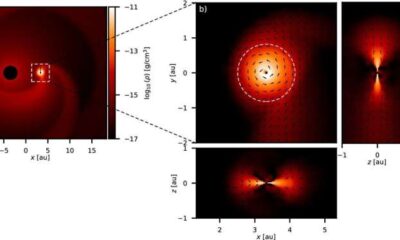Science
Moon Phase Update: Discover the Waning Crescent on October 18

The moon tonight, on October 18, 2024, will appear as a waning crescent, with only 8% of its surface illuminated, according to data from NASA’s Daily Moon Observation. As we near the New Moon phase, which marks the end of the lunar cycle, observers will find limited visibility of the moon’s features.
For those equipped with binoculars or a telescope, the Grimaldi Basin—a prominent impact crater measuring approximately 124 miles in diameter—can still be observed, offering a faint glimpse of lunar geography despite the moon’s dim light.
Understanding Moon Phases
Moon phases are a result of the moon’s orbit around Earth, completing a full cycle approximately every 29.5 days. As the positions of the Sun, Earth, and Moon shift, the amount of sunlight that reflects off the moon’s surface changes, creating various visible phases.
The main phases include:
– **New Moon**: The moon is positioned between Earth and the Sun, rendering it invisible.
– **Waxing Crescent**: A small portion of the moon’s surface begins to light up on the right side.
– **First Quarter**: Half of the moon is illuminated, resembling a half-moon.
– **Waxing Gibbous**: The moon is more than half lit but not yet full.
– **Full Moon**: The entire face of the moon is fully visible and illuminated.
– **Waning Gibbous**: The illumination begins to decrease on the right side.
– **Third Quarter (or Last Quarter)**: The left side is lit, appearing as another half-moon.
– **Waning Crescent**: A thin sliver of light remains before the moon returns to darkness.
The next full moon will occur on November 5, 2024, providing a more stunning view for lunar enthusiasts and casual observers alike. As the moon continues its journey through the night sky, understanding these phases enhances appreciation for our celestial neighbor.
-

 Science2 months ago
Science2 months agoOhio State Study Uncovers Brain Connectivity and Function Links
-

 Politics2 months ago
Politics2 months agoHamas Chief Stresses Disarmament Tied to Occupation’s End
-

 Science1 month ago
Science1 month agoUniversity of Hawaiʻi Joins $25.6M AI Project for Disaster Monitoring
-

 Science4 weeks ago
Science4 weeks agoALMA Discovers Companion Orbiting Giant Star π 1 Gruis
-

 Entertainment2 months ago
Entertainment2 months agoMegan Thee Stallion Exposes Alleged Online Attack by Bots
-

 Science2 months ago
Science2 months agoResearchers Challenge 200-Year-Old Physics Principle with Atomic Engines
-

 Entertainment2 months ago
Entertainment2 months agoPaloma Elsesser Shines at LA Event with Iconic Slicked-Back Bun
-

 World1 month ago
World1 month agoFDA Unveils Plan to Cut Drug Prices and Boost Biosimilars
-

 Business2 months ago
Business2 months agoMotley Fool Wealth Management Reduces Medtronic Holdings by 14.7%
-

 Science2 months ago
Science2 months agoInnovator Captures Light at 2 Billion Frames Per Second
-

 Top Stories2 months ago
Top Stories2 months agoFederal Agents Detain Driver in Addison; Protests Erupt Immediately
-

 Entertainment1 month ago
Entertainment1 month agoBeloved Artist and Community Leader Gloria Rosencrants Passes Away









